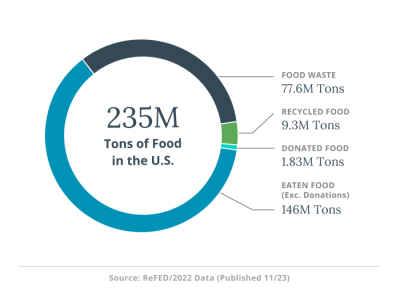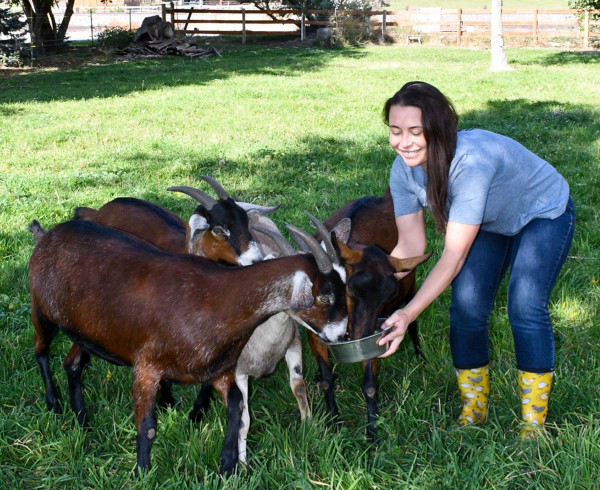
Embracing a Solution Mindset for International Day of Awareness of Food Loss and Waste
In 2014, I stumbled upon a book that would change the way I viewed waste forever: "Zero Waste Home" by Bea Johnson.1 The book wasn’t just a collection of tips and tricks for reducing household waste; it was a manifesto for a more mindful, less wasteful way of living. It sparked a journey that started with small changes at home and gradually extended into my professional life, as I began to explore how these principles could be applied more broadly. Over the years, I’ve found myself not only striving to reduce my own waste but also seizing every opportunity to share what I’ve learned with friends, colleagues, and anyone else willing to listen.
As we mark the International Day of Awareness of Food Loss and Waste on Sept. 29, let's take a look at seven crucial figures that highlight the scale of the problem, and propose some practical, uplifting solutions that we can all implement—at home, at work, and even in the pet food industry.
Seven shocking figures about food loss and waste
- 1.3 Billion Tons of Food Wasted Annually: According to the Food and Agriculture Organization (FAO), roughly one-third of all food produced for human consumption is lost or wasted, amounting to about 1.3 billion tons per year.2 This figure underscores the massive inefficiency in our global food system.
- $1 Trillion in Economic Loss: The Boston Consulting Group (BCG) estimates that the global economic cost of food waste is above $1 trillion annually.3 This staggering sum reflects not only the value of the food itself but also the wasted resources used to produce it.
- 8% of Global Greenhouse Gas Emissions: Food waste is responsible for approximately 8% of global greenhouse gas emissions, according to the United Nations Environment Programme (UNEP) and the World Resources Institute (WRI).4 This makes food waste a major contributor to climate change.
- 45% of Fruits and Vegetables Wasted: The FAO reports that nearly 45% of all fruits and vegetables produced globally are wasted.5 This category of food loss is particularly high due to spoilage, inefficiencies in the supply chain, and consumer behavior.
- 931 Million Tons of Food Waste Annually from Households, Retail, and Food Service: A 2021 UN report reveals that households, retail, and food services generate around 931 million tons of food waste each year.6 This figure highlights the need for better waste management practices at all levels of the food chain.
- 35% of Food Waste in the U.S. Comes from Grocery Stores: ReFED, a national nonprofit, reports that in the United States, grocery stores are responsible for about 35% of the country’s total food waste.7 This waste often occurs due to overstocking, aesthetic standards, and logistical challenges.
- $165 Billion of Food Wasted Annually in the United States: The Natural Resources Defense Council (NRDC) estimates that food waste in the United States is worth $165 billion annually, with a significant portion occurring at the consumer level.8 This highlights the need for greater awareness and behavioral change among individuals.

Uplifting Solutions: What We Can Do
At Home
- Buy Less, More Often: In many European countries, it’s common to shop for groceries multiple times a week, purchasing only what’s needed for the next few days. This reduces the likelihood of food spoiling before it’s used and encourages more mindful consumption.
- Buy Local, In Season If Possible: Supporting local farmers and producers not only boosts the local economy but also reduces the carbon footprint associated with transporting food over long distances. Local produce is often fresher, which means it lasts longer and results in less waste.
- Repurpose & Compost: It’s both gratifying and more responsible to divert “fatigued” produce by feeding farm animals (chickens, pigs, cows, ducks, goats, etc…) or composting if the fruits or vegetables went bad. Of course, always check if the fruits and/or vegetables are healthy for the animals being fed.

Emilie with her rescued goats, feeding them kitchen scraps.
At Work
- Use Leftovers: It sounds simple, but taking leftovers from restaurants can reduce food waste. When I go out with my colleagues, I also kindly ask if I can take their leftovers with me, if they are not interested themselves. Bonus points for using a re-usable container from home! This simple habit helps reduce waste from the still too common polystyrene to-go container and single use plastic bag.
- Plan Business Events Wisely: When organizing office or business events or outings, try to anticipate the right amount of food needed to avoid excess. If there are leftovers, consider donating them to local shelters or food banks.
- Provide A Compost Bin: In 2014, my husband brought an additional compost bin and donated it to his work. He started educating his colleagues about what can be disposed of in it. People were more interested and receptive than anticipated! Every Friday, he would bring it back home to feed our own compost.

Our kitchen compost bin, the same we donated to a work office.
In the Pet Food Industry
- Feed the Right Quantities: In the U.S., 60% of cats and dogs are considered overweight or obese, according to the Association for Pet Obesity Prevention.9 By feeding pets the right amount of food, we can not only reduce waste but also improve their health. From experience, the pet food most wasted seems to be canned food and fresh foods, as they require to be discarded shortly after being left out at room temperature. Getting to know one’s pet’s appetite and preferences should be a factor in determining how much food to offer, and how often.
- Use Upcycled Ingredients: The pet food industry shows a growing trend of using upcycled ingredients—food that would otherwise go to waste but is safe and nutritious for pets. This practice not only reduces waste but also creates new revenue streams for companies, in an industry with constant ingredient shortages and pressures.
Positive Examples: Turning Waste into Opportunity
- Shameless Pets: Companies like Shameless Pets are leading the way in using upcycled ingredients. They advertise their commitment to using upcycled ingredients in every product they make. They have been able to save 2 million pounds of food from going to the landfill.10 This number can be disappointing, it’s probably due to the current volumes of treats being sold, and the upcycled ingredients inclusion rates. What’s important is that these businesses show that waste can be a resource rather than a liability, and they’re helping shift perceptions in the eye of the pet parent.
- CSS (California Safe Soils): This innovative company is using grocery store waste to create palatants—substances that enhance the taste of pet food. They utilize only foodstuffs that have been USDA approved for human consumption, which answers the consumer preference for knowing the origin of inputs into pet foods and treats.11 By repurposing food that would otherwise be discarded, CSS is turning problematic waste into a valuable ingredient.
A Call to Action
The figures are daunting, but they should inspire action, not despair. Whether at home, at work, or within the petfood industry, there are countless ways to reduce food waste and make a positive impact. Start with small changes, share the journey with others, and advocate for systemic changes that prioritize sustainability and efficiency. By working together, we can transform the way we think about food waste and build a future where every bite counts.
Learn more about the International Day of Awareness of Food Loss and Waste from the Food and Agriculture Organization of the United Nations here.
References
- Zero Waste Home: The Ultimate Guide to Simplifying Your Life by Reducing Your Waste. (2013). Scribner
- Food and Agriculture Organization of the United Nations (FAO). (2011). Global food losses and food waste chapter.chrome-extension://efaidnbmnnnibpcajpcglclefindmkaj/https://www.fao.org/4/mb060e/mb060e00.pdf
- Boston Consulting Group (BCG). (2018). Tackling the 1.6-Billion-Ton Food Loss and Waste Crisis.https://www.bcg.com/publications/2018/tackling-1.6-billion-ton-food-loss-and-waste-crisis
- United Nations Environment Programme (UNEP), World Resources Institute (WRI). (2019). Reducing Food Loss and Waste.https://www.wri.org/reducing-food-loss-and-waste-ten-interventions-scale-impact
- (2019). The State of Food and Agriculture: Moving Forward on Food Loss and Waste Reduction.chrome-extension://efaidnbmnnnibpcajpcglclefindmkaj/https://openknowledge.fao.org/server/api/core/bitstreams/11f9288f-dc78-4171-8d02-92235b8d7dc7/content
- United Nations Environment Programme. (2021). Food Waste Index Report 2021. https://www.unep.org/resources/report/unep-food-waste-index-report-2021
- ReFED. (2020). Roadmap to 2030: Reducing U.S. Food Waste by 50%. https://refed.org/food-waste/the-solutions/
- Natural Resources Defense Council (NRDC). (2017). Wasted: How America Is Losing Up to 40 Percent of Its Food from Farm to Fork to Landfill. https://www.nrdc.org/resources/wasted-how-america-losing-40-percent-its-food-farm-fork-landfill
- Association for Pet Obesity Prevention. (2023). The Current State of Pet Obesity in the United States. https://www.petobesityprevention.org/2023
- Shameless Pets – upcycling. https://shamelesspets.com/pages/whatsupcycling
- California Safe Soils (CSS). Recovering Supermarket Food to Produce Pet Food Ingredients. https://www.calsafesoil.com/pet-nutrition
Follow us on LinkedIn for the latest updates on all things happening here at BSM Partners.
About the Author
Émilie Mesnier's passion for pets ignited during a 2007 internship in palatability research and has propelled her ever since. A French-trained food scientist, she now blends two decades of global know-how—nutrition, marketing, sustainability, animal welfare and international growth—into one goal: better foods and lives for animals. A lifelong learner who has absorbed insights from 80-plus business books on strategy and continuous improvement, Émilie turns ideas into action every day. After 16 years in the US and running a small farm animal rescue sanctuary in Utah, Emilie moved children, husband and two senior pets back to France in early 2025 to bring BSM Partners’ full suite of consulting services closer to clients across the European market.
This content is the property of BSM Partners. Reproduction or retransmission or repurposing of any portion of this content is expressly prohibited without the approval of BSM Partners and is governed by the terms and conditions explained here.